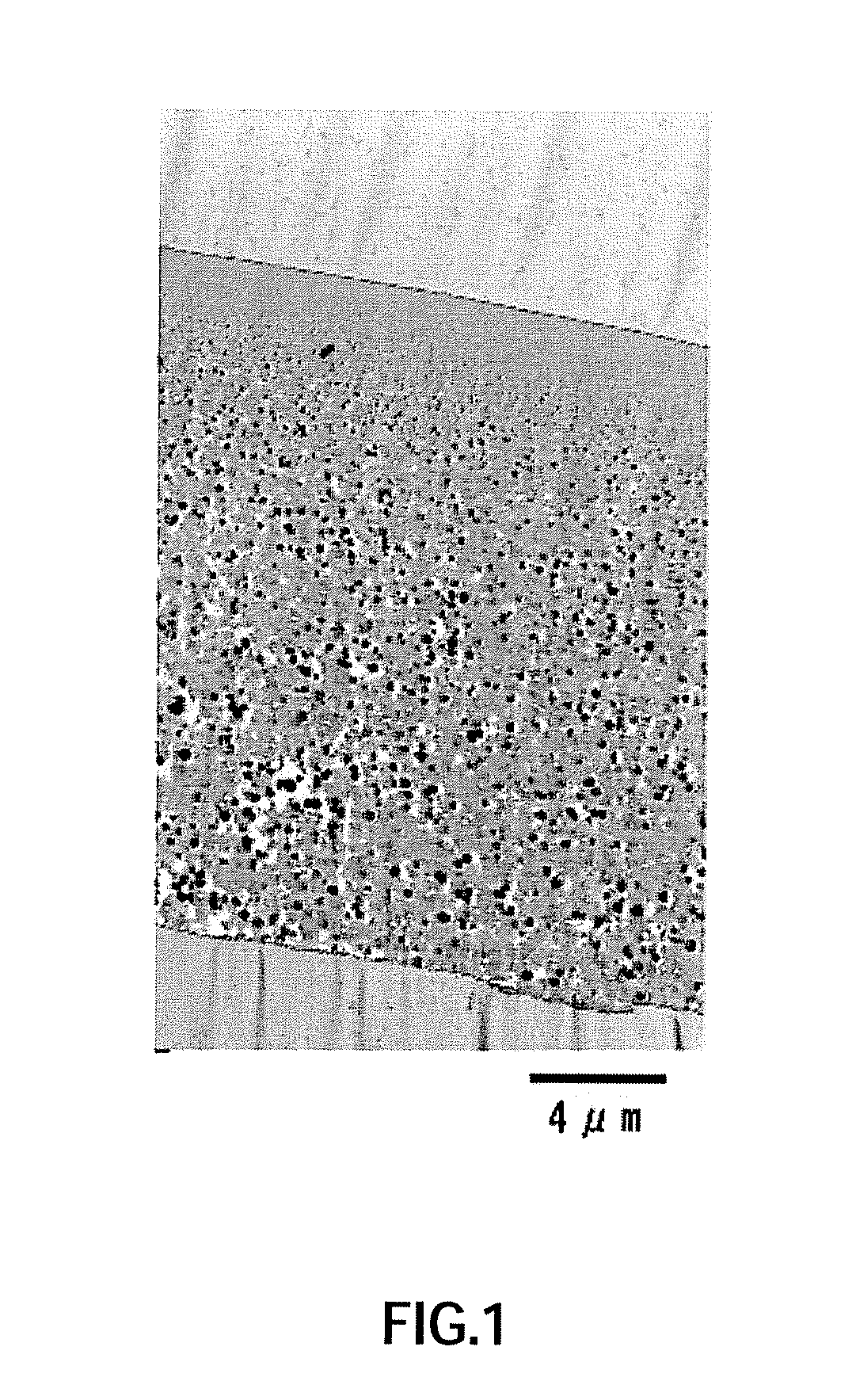Optical film and method for producing same
a technology of optical film and surface smoothness, applied in the field of optical film, can solve the problems of difficult suppression of coagulation of particles, high scattering efficiency of specific wavelength, etc., and achieve the effects of high light diffusing property, excellent surface smoothness, and excellent light diffusing property
- Summary
- Abstract
- Description
- Claims
- Application Information
AI Technical Summary
Benefits of technology
Problems solved by technology
Method used
Image
Examples
example 1
[0225]Step (E): PMMA (1.0 g) which is a transparent resin and NMP (4.0 g) which is a solvent were mixed to prepare 5 g of a PMMA / NMP solution of 20% by weight of PMMA.
[0226]Step (F): A 20 ml reaction vessel was charged by the 5 g of the PMMA / NMP solution of 20% by weight of PMMA obtained in Step (E). Subsequently, TMOS (1.0857 g) which is a metallic compound that forms a metallic oxide by a sol-gel reaction and a 0.1 N HCl aqueous solution (0.5136 g) were added into the flask so that the content rate of a metallic oxide in the resulting film is 30% by weight, followed by performing reaction at room temperature for 5 hours. The 0.1 N HCl aqueous solution was diluted to 50% by weight with NMP and then added.
[0227]Step (G): The resulting solution was applied on a glass substrate using a baker applicator so that the dried film thickness is approximately 35 μm. Subsequently, the glass substrate was heated from 50 to 120° C. at a temperature rising rate of 3° C. / min under a nitrogen atmos...
example 2
[0229]A PMMA-silica composite film having a film thickness of 35 μm was prepared in the same manner as Example 1 except that TMOS (0.6333 g) and a 0.1 N HCl aqueous solution (0.2996 g) were used so that the content rate of a metallic oxide in the optical film is 20% by weight. The resulting film had a total light transmittance of 92.0%, a total light reflectance of 75% and a haze of 24%.
example 3
[0230]Step (E): PMMA (1.0 g) and DMAc (4.0 g) were mixed to prepare 5 g of a PMMA / DMAc solution of 20% by weight of PMMA.
[0231]Step (F)
[0232]A 20 ml reaction vessel was charged by the 5 g of the PMMA / DMAc solution of 20% by weight of PMMA obtained in Step (E). TMOS (1.0748 g) and a 0.1 N HNO3 aqueous solution (0.5123 g) were added into the flask so that the content rate of a metallic oxide in the resulting film is 30% by weight, followed by performing reaction at room temperature for 2 hours. The 0.1 N HNO3 aqueous solution was diluted to 50% by weight with DMAc and then added.
[0233]Subsequently, APTMOS (0.0128 g) was added to the solution, followed by performing reaction at room temperature for 2 hours. At this time, APTMOS was diluted to 10% by weight with DMAc and then added.
[0234]Step (G): The solution obtained in the above Step was applied on a glass substrate using a baker applicator so that the dried film thickness is approximately 15 μm. Subsequently, the glass substrate was...
PUM
| Property | Measurement | Unit |
|---|---|---|
| total light transmittance | aaaaa | aaaaa |
| total light transmittance | aaaaa | aaaaa |
| thickness | aaaaa | aaaaa |
Abstract
Description
Claims
Application Information
 Login to View More
Login to View More - R&D
- Intellectual Property
- Life Sciences
- Materials
- Tech Scout
- Unparalleled Data Quality
- Higher Quality Content
- 60% Fewer Hallucinations
Browse by: Latest US Patents, China's latest patents, Technical Efficacy Thesaurus, Application Domain, Technology Topic, Popular Technical Reports.
© 2025 PatSnap. All rights reserved.Legal|Privacy policy|Modern Slavery Act Transparency Statement|Sitemap|About US| Contact US: help@patsnap.com


